Game 277: The Tower of Myraglen (1987)
Game 277: The Tower of Myraglen (1987) - Hallo Guyst Review Games Update, In the article you read this time with the title Game 277: The Tower of Myraglen (1987), we have prepared this article well for you to read and take information in it. hopefully the post content what we write can you understand. alright, happy reading.
Title : Game 277: The Tower of Myraglen (1987)
link : Game 277: The Tower of Myraglen (1987)
You are now reading the articlel Game 277: The Tower of Myraglen (1987) with link address https://reviewgameupdate.blogspot.com/2018/01/game-277-tower-of-myraglen-1987.html
Title : Game 277: The Tower of Myraglen (1987)
link : Game 277: The Tower of Myraglen (1987)
Game 277: The Tower of Myraglen (1987)
The Tower of Myraglen
United States
PBI Software (developer and publisher)
Released in 1987 for Apple IIGS
Date Started: 31 December 2017
Date Ended: 2 January 2018
Total hours: 8
Total hours: 8
Difficulty: 3/5 (Moderate)
Final Rating: 25
Ranking at Time of Posting: 117/282 (41%)
The occasional short action-oriented top-down arcade-style dungeon-crawler offers a nice change of pace. In this case, the change of pace was so welcome that I got to the end before reflecting that the game really isn't an RPG. It fails all three of my core criteria: the only character development is through acquisition of weapons and armor, those items automatically replace inferior ones, and there's no other determinant of combat effectiveness.
And yet, the game shows a certain RPG root. This makes sense, because author Richard Seaborne originally conceived it as a tabletop Dungeons & Dragons module. This is Seaborne's first game, but owing to the screwed-up way I started this blog, it's the last one I'll be reviewing. We previously saw his work on Prophecy: The Fall of Trinadon (1988) and Escape from Hell (1990), the latter a wonderfully meta game in which you play Richard Seaborne, who is stuck in Hell to prevent him from finishing Escape from Hell.
 |
| "Hell" is something of a theme in Seaborne's work. |
The backstory here is simple. Evil has beset the kingdom of Myraglen from all sides, and its only hope of survival lies in the Medallion of Soul Stealing, an artifact so evil that its creator, the archmage Mendalick, created a trap- and monster-filled tower just to hide it. Unfortunately, using the wicked medallion is the lesser of two evils at this point, so the king dispatches one of his knights to retrieve it.
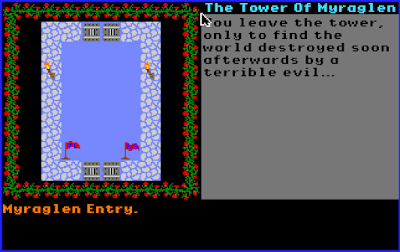 |
| You can immediately leave the Tower and get a "bad" ending. |
The player--who doesn't even get to choose a name for his character--has to battle his way up nine tower levels, fighting monsters, collecting gold and upgrades, assembling artifacts and keys, finding secret doors, and solving light puzzles. You can control with the mouse or keyboard. In either case, controls are minimal. Most of what you do is walking (IJKM cluster), opening chests and taking items, checking your inventory, and checking your statistics. Occasionally, you have to use "L" to look at something, or "Y" to yell a password or the answer to a question. The WASX cluster fires arrows in the four directions, but I hardly ever used it. Unusually, when you indicate a direction of movement, you keep moving until an obstacle blocks you or you hit another key. There are times that you only want to move one space at time, so you have to do that by holding down the CTRL key while moving. You can also set the game speed, from excruciatingly slow to so blindingly fast that you can barely stop yourself from running into lava.
I'm going to avoid a blow-by-blow account of the tower, as Crooked Bee has already offered a detailed LP that goes into plenty of detail. Particularly since it isn't an RPG, I'm less interested in writing about the game than about its connections with the rest of Seaborne's work. But I can't get away without at least summarizing it. It starts out fairly easy on the first couple of levels. The monsters are relatively easy to kill and the treasure chests deliver steady upgrades. Except for the rare key or special artifact, the loot found in treasure chests is random. You may get just gold, or gold and a weapon, or gold and some armor, or a "strength" potion that increases your hit points. If you find a weapon or armor that beats what you already have, it automatically equips and thus raises your offensive and defensive scores. Early in the game, the best weapon is a halberd and the best armor is plate mail; later, versions of the same items with "magic" in front of them become the best. Some players will inevitably find those items early in their levels and face an easier game than those who have to build up to them. The same kind of randomness in treasure acquisition characterized Prophecy.
 |
| I would have had to screw up a lot to be excited about a short sword this late in the game. |
Potions also make a big difference. If you get lucky and find them regularly, you don't have to worry much about dying. Other players will find potions rarely and thus face a harder game. However, when you die, you have the option to start over at the base of the tower with all your equipment and gold intact, all of the tower rooms, chests, and enemies the way you left them, and a new complement of 1,000 hit points. Thus, persistence will always save you in the end as long as you don't mind marching back up the tower to where you last died. You can also save anywhere and reload, but sometimes your low hit points put you in a walking dead situation where you can't survive in any direction, and thus rebirth is the only way to go.
There are really no combat tactics at all except to try to avoid getting hit by multiple enemies at once. You fight by charging into the enemy and by continuing to move in his direction until he dies or you retreat. Yes, you have a Ring of Unlimited Arrows that lets you shoot arrows in every direction, but enemies close the distance so fast, and the arrows do so little damage, that it's barely a viable tactic.
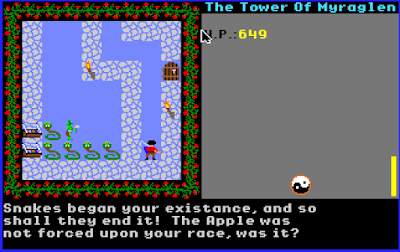 |
| A few of the game's foes. Note the taunting messages. |
The manual lovingly describes each of the game's couple dozen enemies, but since you only have one way to defeat them, little matters except their hit points and how much damage they do relative to your protection level. A few are capable of ranged attacks. A few are invisible. A couple are disguised as environmental features, such as living walls and living water. At least one, the "indescribable beast," is functionally unkillable. Fortunately, no monster in the game must die, so if the room is open enough, you can often run around them, grab the treasure they're guarding, and head for the exit. Enemies don't follow from screen to screen.
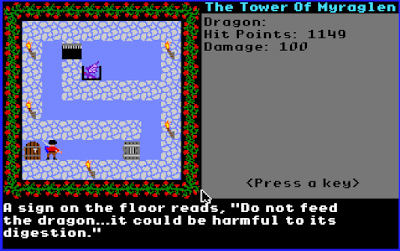 |
| There would be no reason to waste hit points killing this dragon. He guards no treasures or passages. |
What makes Myraglen transcend the typical RPG, or typical action game, is how the story develops during the player's progress. Seaborne strikes me as a developer who fundamentally wanted to tell a story more than he wanted to develop the mechanics of a game: witness his epic intentions for Escape from Hell, which he was forced to cut to three levels from a planned nine. Both Myraglen and Prophecy tell more interesting stories than their mechanics really support, and both have twists and multiple endings.
In Myraglen, the first twist comes on the first level, when you look into a mirror and get a long block of text, the first part re-telling the story of how and why Mendalick built the tower. But immediately after it, you see a glimpse of the future, of what will happen when you give the Medallion of Soul Stealing to the king. You realize that the king is actually the source of the kingdom's evil, and that he will use the Medallion not to save Myraglen but to enslave the rest of the world. But you have no choice but to continue the quest anyway, because you've also seen what will happen if the evil already set in motion continues unchecked.
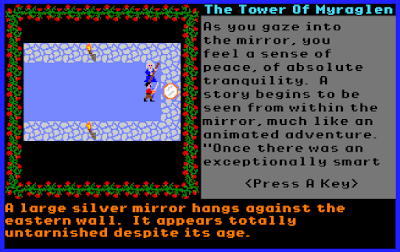 |
| I'm not 10 minutes into the game, and the author is pulling out the rug. |
As you work your way up the tower, you periodically get visions of the "good" and "bad" sides of Mendalick, the former trying to help your quest, the latter trying to subvert it. "Good" Mendalick is strongest on the early levels, but as you go up, his helpful advice is replaced by frequent insults and screeds from his evil counterpart.
 |
| This guy is giving me bad advice. |
The puzzles in the game are mostly easy but some are interesting nonetheless. On Level 1, you have to get a key from a hidden place in a fireplace. The trick is that you can only do it when a nearby clock is set to 12--either noon or midnight. How do you set the clock? You don't. It's based on your own system clock, so either you have to wait until noon or midnight or manually set your computer to those times. I happened to get extraordinarily lucky on this one, as I was playing during the midnight hour when I encountered the puzzle. The game remains in tune with your system clock throughout, incidentally, and chimes an appropriate number of times every hour.
On Level 2, you have to "resist temptation" by ignoring a whole room full of treasure chests, even though you happily loot them everywhere else. On the same level, you have to find some clues to ignore a sphere making an ungodly amount of noise (and you aren't just told that it's making the noise; you hear it through the speakers) to avoid an instant death.
 |
| Resisting temptation is only a virtue when there's a lot of temptation. |
Level 3 has an enormous room, taking up multiple screens, that's full of invisible mines and traps. They damage you and make your hard-won weapon and armor disappear, sending you back to leather and a short sword. You can suck it up or do what I did and map a safe path and then reload. Level 3 also starts to introduce rooms that are functionally impossible until you've earned more hit points at higher levels.
Level 4 introduces an area of continually-shifting black and white squares, the white ones safe and the black ones deadly. You have to mince your way through them to get a Ring of Fire Resistance for later levels.
 |
| Careful, single-square movement was necessary here. |
Level 5 offers this riddle:
A creature of your world that spins reality into dreams, and puts hope in the hands of the forgotten. This creature also paints the image of death and slaughter so well, that a man may even cry from its force. What is the title of such a beast?
I thought about it for a while, then tried POET, and was extremely pleased with myself when the way forward opened. Then I read Crooked Bee's LP and saw that she got the same result with KING. So either there are multiple answers or you can just say anything. (CRPG DEVELOPER.)
It took me three character "rebirths" to get to Level 5, but the level has a game-changing element: a brazier that gives you 1 hit point for every 10 gold pieces you feed to it. There's another one of these on Level 8. I had nearly 100,000 gold when I got here, and I earned a couple hundred thousand more on the subsequent levels. Thus, after this point, I was in no danger of dying in combat. The braziers really unbalance the last few levels of the game.
 |
| From this moment, the game is pretty easy. |
Level 7 introduces doppelgangers--clones of the PC with several hundred hit points. They're very tough to kill, but they don't seem terribly interested in killing you. In fact, when you enter a room with four of them, they argue whether to kill you or not. Mostly, you can just run around them.
Level 8 has a bridge that has like a 50/50 chance of collapsing when you try to cross it, resulting in instant death. I had to reload a couple of times. The rest of the level is composed of 20 x 20 screens of "dark planes," a few of them with enemies or treasure, but most of them empty. You have to explore every damned one, because progress depends on finding two or three keys among the 400 screens.
 |
| This is uncomfortably random. |
When I got to Level 9, I couldn't progress even though I had all the necessary keys. The door they were supposed to open just said "food for thought?" I had to consult a walkthrough to find what I'd missed. It turns out that one of the food troughs on Level 6 had something in it. Nowhere else in the game do food troughs hold items, but it's worth mentioning that Seaborne included food troughs in most rooms that have enemies--he even mentions them in the manual--because he thought it was unrealistic that these animals would just exist in those rooms for year after year with nothing to eat.
 |
| I guess maybe the message at the bottom was supposed to be a clue to search everything. |
Anyway, the trough on Level 6 holds a message that basically constitutes Mendalick's--and thus Seaborne's--personal bible. It has a couple of paragraphs extolling personal responsibility and rejecting organized religion, and then it offers 11 "commandments":
- Never lie
- Be compassionate
- Never steal
- Respect property
- Protect kin and protect friends
- Right all wrongs [you have] committed if possible
- Attempt to be successful in all [you do]
- Be persistent
- Aid those who need help, provided it will not bring harm upon [you]
- View others by their actions, not by their appearance
- Be proud of [your] beliefs and speak them aloud when requested
It's the Old Testament crossed with Zig Ziglar. In some ways, I admire Seaborne's attempt to out-virtue Lord British, but the difference is that Richard Garriott created a game in which the player practiced and exemplified those virtues, whereas Myraglen offers so little in the way of application that the sermonizing feels a little out-of-place. I don't disagree with the prescriptions, though, except maybe the last one.
The game ends on Level 9 after a couple of rooms with large battles.
Messages warn that you're killing Mendalick with every step forward you take, and sure enough you find his body at the end of the level. But he's at peace, and he "lives on in the tower." You take the medallion from his body and, via a series of questions, get four choices for ending the game.
 |
| They are no match for my absurd hit point total. |
Messages warn that you're killing Mendalick with every step forward you take, and sure enough you find his body at the end of the level. But he's at peace, and he "lives on in the tower." You take the medallion from his body and, via a series of questions, get four choices for ending the game.
 |
| The Medallion of Soul Stealing. |
1. Give the medallion to the king. The king "laughs mercilessly" and sucks out your soul. Game over.
 |
| The definition of "lawful neutral." |
2. Keep the medallion for yourself and conquer the world. You find that the medallion doesn't protect you from everything.
3. Don't give it to the king, but also don't use it. You settle down to a life of peace, but the existing minions the king has unleashed hunt you down.
4. Kill the king with it. This is the one "good" ending. You get the message below, followed by an image of Mendalick and some triumphant music.
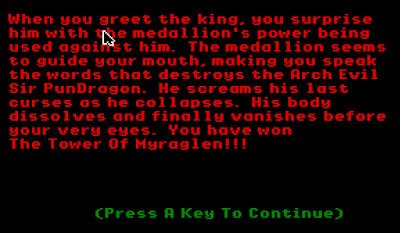 |
| I forgot to mention that, in a non-highlight of the game, the king's name is "Sir PunDragon." |
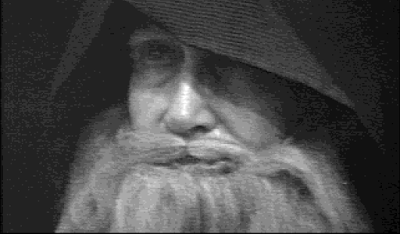 |
| What are the odds on this being Richard Seaborne in a fake beard? |
No matter what, you get to enter your name or hero's name in the "Hall of Honor." You also get to do this every time the character dies.
In addition to her LP, Crooked Bee also offers a long interview with Richard Seaborne on RPG Codex in January 2015. In it, he describes how he wrote both Prophecy and Myraglen as Dungeons & Dragons modules but couldn't get TSR interested. When the Apple IIGS came out, he saw an opportunity to make a name for himself on an otherwise-neglected platform and turned Myraglen into a game.
He had intended to offer the game to Electronic Arts, whose headquarters was near his house. He got in his car one day and headed to the offices without an appointment, hoping someone would be impressed enough with the game to overlook the breach of protocol. Unable to find the EA offices, he instead stumbled upon PBI Software a few blocks away, walked in, and walked out with a contract. In addition to Myraglen, he also worked on Cavern Cobra, Sea Strike, and Monte Carlo, all published the same year.
 |
| The developer has a little in-game trophy. |
Seaborne would later work for EA, and then Microsoft Studios, but in executive roles rather than direct development and programming. His small portfolio of RPGs (or quasi-RPGs) showed them getting better over time, and in some ways it's too bad that he stopped designing games before creating a real masterpiece, because there are flashes of genius in each of his titles. This is seen primarily in his thoughtful stories, always interjected with bits of philosophy. Recall the dialogues between God and Satan in Escape from Hell and the plot twist involving the three demons in Prophecy. His dedication to storytelling appears in minor ways as well, such as the tabletop module-like treatment of each room as a unique space, with a few lines of accompanying text, rather than just a featureless corridor or abattoir.
 |
| Most of the rooms have descriptions like this. |
Unfortunately, his games had a long way to go in mechanics. All three titles have flawed inventory systems. The combat systems in Myraglen and Prophecy are all under-developed, and for Escape he simply copied the standard Interplay system used in The Bard's Tale and Wasteland. His credits often show him paired with other programmers on graphics and sound, but never in these more substantive areas. In some ways, it's too bad that he didn't go to work for Origin or SSI, where his story and role-playing ideas might have found purchase with more experienced developers of RPG engines.
I assigned Myraglen a 25 on the GIMLET, but it's important to recognize that it fundamentally isn't an RPG and thus under-performs in GIMLET categories like "character creation and development" (0), "magic and combat" (1), and "equipment" (1). It does best in the "game world," "quests" for the multiple endings, and overall "gameplay" for its moderate length and difficulty (all 4s). If I had played this in the right chronological order, I'd end this review by saying I look forward to seeing more from this developer. As it is, I'm grateful for the little we got.
 |
| I have no theories on the source of "Myraglen." |
I assigned Myraglen a 25 on the GIMLET, but it's important to recognize that it fundamentally isn't an RPG and thus under-performs in GIMLET categories like "character creation and development" (0), "magic and combat" (1), and "equipment" (1). It does best in the "game world," "quests" for the multiple endings, and overall "gameplay" for its moderate length and difficulty (all 4s). If I had played this in the right chronological order, I'd end this review by saying I look forward to seeing more from this developer. As it is, I'm grateful for the little we got.
At All Articles Game 277: The Tower of Myraglen (1987)
Thanks For Reading Game 277: The Tower of Myraglen (1987) this time, hopefully it can benefit you all. alright, see you in another article post.
You are now reading the articlel Game 277: The Tower of Myraglen (1987) with link address https://reviewgameupdate.blogspot.com/2018/01/game-277-tower-of-myraglen-1987.html




0 Response to "Game 277: The Tower of Myraglen (1987)"
Posting Komentar